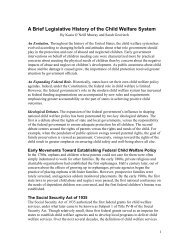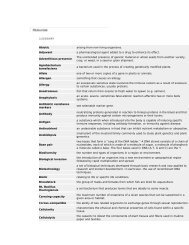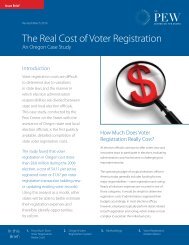Protecting Western Australia's Big Blue Backyard - The Pew ...
Protecting Western Australia's Big Blue Backyard - The Pew ...
Protecting Western Australia's Big Blue Backyard - The Pew ...
Create successful ePaper yourself
Turn your PDF publications into a flip-book with our unique Google optimized e-Paper software.
CRUSTACEANS AND MOLLUSCS RULE<br />
High-value crustaceans are king of the fisheries in<br />
<strong>Western</strong> Australia. According to the most recent<br />
status reports for <strong>Western</strong> Australia’s fisheries, the<br />
catches of western rock lobster, blue swimmer<br />
crabs, deep sea crabs and prawns were worth<br />
$335 million in 2007.<br />
Molluscs are next in dollar-value importance,<br />
with the pearl oyster industry in the state’s north<br />
providing another $122 million. <strong>The</strong> annual<br />
harvest of Roe’s, greenlip and brownlip abalone<br />
was valued at $12 million. Sharks, goldband<br />
and pink snapper, spanish mackerel, baldchin<br />
groper, pilchards, Australian salmon and other fish<br />
contributed more than $40 million to the <strong>Western</strong><br />
Australian economy.<br />
State-managed commercial fisheries on the<br />
west coast of the Kalbarri to Eucla region are<br />
dominated by the western rock lobster. Line fishing<br />
for West Australian dhufish and pink snapper is<br />
also significant but the fish stocks are in decline.<br />
Commercial fishing for these and other species has<br />
now been banned within the Perth metropolitan<br />
area as a first response to help reduce pressure<br />
on them.<br />
Roe’s abalone grazes the inshore reefs in shallow<br />
waters and is prised from the rocks by local<br />
abalone divers. Crab fishers set pots for deep<br />
sea crabs—king, champagne and crystal—on the<br />
upper continental slope.<br />
Smaller state-managed fisheries target bait,<br />
pilchards, squid, blue swimmer crabs, saucer<br />
scallops and estuary fish. Concerns have been<br />
expressed about the impact that saucer scallop<br />
trawling has on sponges and corals and the<br />
accidental catch of sea snakes, turtles and sharks.<br />
On the south coast the most valuable fishery is for<br />
greenlip and brownlip abalone, which are collected<br />
from algae-covered reefs. <strong>The</strong>se reefs provide few<br />
habitats for rock lobsters and crabs compared with<br />
west coast reefs and, as a result, the south coast<br />
crustacean fishery is tiny in comparison to that on<br />
the west coast.<br />
<strong>The</strong> harvest of fish is relatively more important on<br />
the south coast than the west coast due to cooler<br />
waters, the presence of temperate species and the<br />
affects of canyon upwellings along the continental<br />
slope. <strong>The</strong> shark and finfish fishery is second in<br />
value to the abalone fishery, and the pilchard<br />
fishery third. Small fisheries also exist for Australian<br />
salmon, herring and estuarine species.<br />
Of the Commonwealth-managed fisheries in<br />
the region, longline fishing in the Indian Ocean<br />
targets skipjack, albacore, yellowfin and bigeye<br />
tuna, striped marlin and swordfish. Trawl nets are<br />
dragged across the fragile sea floor communities<br />
of the west coast’s continental slope seeking bugs,<br />
ruby snapper and orange roughy. Pilchards, orange<br />
roughy, deepwater flathead and bight redfish are<br />
the main species taken in Commonwealth fisheries<br />
on the south coast.<br />
22<br />
When assessing commercial fisheries operating<br />
within Commonwealth waters for its profile<br />
of the South-west Marine Region, the federal<br />
environment department found that in the Kalbarri<br />
to Eucla region there are targeted species that are<br />
‘overfished’ in two fisheries, ‘fully fished’ in three<br />
fisheries and ‘uncertain’ in two fisheries.<br />
Four fisheries had not been assessed.<br />
<strong>The</strong> number of recreational fishers is growing in<br />
the region, and they now have more fishing time<br />
available because of retirement, semi-retirement<br />
or the fly-in/fly-out shift arrangements for workers<br />
in the mining boom.<br />
Recreational fishers target similar species to<br />
commercial fishers on the west and east coasts.<br />
Each year anglers use lobster pots to catch 500,000<br />
western rock lobsters. For some species, such as<br />
West Australian dhufish, baldchin groper and the<br />
breaksea cod, anglers catch more than commercial<br />
fishers. In Cockburn Sound anglers take 80 per<br />
cent of the total fish catch. In estuaries their<br />
harvests are from 30–70 per cent of the commercial<br />
catch, for blue swimmer crabs it is 60 per cent,<br />
while for Roe’s abalone it can be up to one third.<br />
Most of the recreational fishing activity in the<br />
Kalbarri to Eucla region is focused on the west<br />
coast. However, recreational fishing is increasing<br />
on the south coast, despite the area’s stormy seas,<br />
as the population grows, leisure time increases,<br />
boats get bigger and stocks decline on the<br />
west coast.<br />
Like its commercial counterpart, recreational<br />
fishing can remove significant quantities of<br />
fish from the marine environment. This must<br />
be factored in to management and protection<br />
measures if there are to be fish for anglers in<br />
the future.<br />
<strong>The</strong> Kalbarri to Eucla region’s commercial fisheries<br />
are worth hundreds of millions of dollars each year.<br />
Recreational fishing is important in the lifestyle<br />
of many <strong>Western</strong> Australians. But the fish species<br />
that both of these fishing sectors rely upon are<br />
under serious fishing pressure. Establishing a CAR<br />
network of large no-take marine reserves is an<br />
effective way to ensure the future of the region’s<br />
commercial and recreational fisheries.<br />
Establishing a CAR network<br />
of large no-take marine<br />
reserves is an effective way<br />
to ensure the future of the<br />
region’s commercial and<br />
recreational fisheries<br />
This school of rough bullseyes swirling<br />
among plate coral off the coast of<br />
Cape Naturaliste is able to find food<br />
and shelter in sea floor communities<br />
© Glen Cowans
















